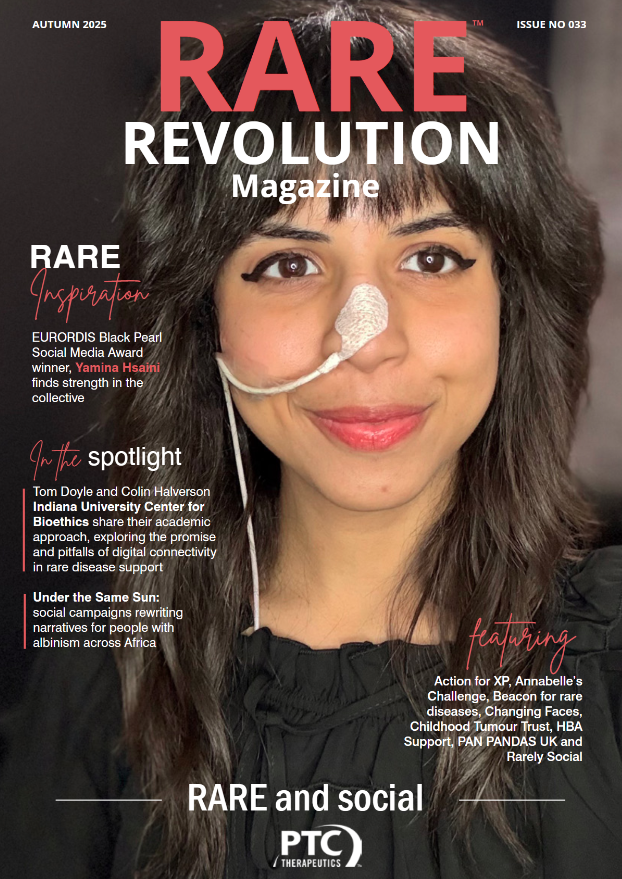The fragile ecosystem: how federal policy changes threaten rare disease research and patient care
Estimated reading time: 8 minutes
In an era of global political volatility, the rare disease community faces a critical moment that could fundamentally reshape medical research, patient support, and scientific innovation. Dr. Wendy Chung a leading expert in rare diseases and chair of paediatrics, Boston Children’s Hospital, offers a stark warning about the potential long-term consequences of the current political trajectory driving federal policy changes

Written by Nicola Miller, RARE Revolution Magazine
Interview with Dr Wendy Chung, chair of paediatrics, Boston Children’s Hospital
The current political landscape presents a triple threat to the rare disease ecosystem. Dr Wendy Chung, chair of paediatrics, Boston Children’s Hospital, USA, identifies three critical areas of concern: research investment, healthcare access and educational support. “What’s most alarming,” she explains, “is not just what’s happening, but the uncertainty itself. This instability makes long-term planning nearly impossible.”
The research ecosystem is particularly vulnerable. The research investment landscape is experiencing seismic shifts that threaten the foundational infrastructure of rare disease science. With proposed 40% cuts to the NIH budget and the elimination of key research leadership positions, universities and academic medical centres face unprecedented challenges. Biotech and pharmaceutical companies have already begun retreating from ultra-rare disease research, leaving a critical gap that academic institutions are struggling to fill.
The disruption extends beyond immediate funding—the peer review process for grants has been destabilised, potentially causing approved research to go unfunded and creating a bottleneck that could halt promising scientific investigations. “We’re losing momentum at a time when scientific technologies are more promising than ever,” Wendy warns. “The original ideas that typically start in universities—which are perhaps too risky for companies to initially invest in—are now at serious risk of dying on the vine.” This threatens not just current research, but the entire pipeline of scientific training and innovation, potentially creating a generational gap in rare disease understanding and treatment development.
The human cost of policy shifts
The proposed federal policy changes also threaten to dismantle critical healthcare infrastructure for rare disease patients, with Medicaid potentially facing devastating cuts that could leave millions without essential medical support. Wendy sets the scene, “currently Medicaid serves one in two children in the United States, providing a lifeline for families managing complex rare conditions”. These potential reductions extend beyond traditional socioeconomic boundaries, impacting middle-class families with children requiring specialised medical care. “It’s not solely low-income person’s health insurance,” Wendy emphasises, “but a critical support system for children and individuals with chronic illnesses.”
The proposed cuts could force families to choose between essential medical treatments and basic living expenses, potentially creating long-term health disparities and increased financial strain. Moreover, the reduction in healthcare access could disproportionately affect rare disease patients who often require complex, multi-disciplinary medical interventions that are costly and specialised. This axe hanging over healthcare support risks not just immediate medical care, but the long-term quality of life and potential for management or treatment of rare conditions.
Policy changes also have the potential to unravel significant strides made in the provision of critical educational support systems for children with rare diseases and special needs, potentially rolling back decades of progress toward inclusive education.
The proposed cuts to the Department of Education could adversely affect individualised educational plans (IEPs), specialised accommodations and support services that enable children with rare conditions to access meaningful educational experiences. These changes disproportionately impact neurodivergent children and those with less visible disabilities, with early indications suggesting funding for autism and neurodiversity support could be dramatically reduced.
“These are critical pathways to independence and better quality of life.” The potential elimination of specialised educational support risks creating generational barriers—limiting educational opportunities and potentially reducing future workforce participation for individuals with rare conditions. This systemic reduction threatens not just educational access, but the broader societal integration and potential of children with rare diseases, potentially reversing years of progressive educational policy designed to create inclusive, supportive learning environments.
A Global Ripple Effect—beyond US borders
The impact of US federal policy changes reaches far beyond national boundaries, creating a complex web of international scientific and medical consequences. Historically, the US has been a global leader in medical research, with universities and research institutions attracting and training top scientific talent from around the world. The current policy shifts threaten this delicate international ecosystem of knowledge exchange and collaborative research.
Recent restrictions on foreign research components have already begun to disrupt critical international collaborations. Researchers who once viewed US institutions as premier training grounds are now reconsidering their academic and professional trajectories. “These policies don’t just cut funding,” Wendy explains, “they sever the intricate networks of scientific collaboration that take decades to build.”
The ripple effect is particularly pronounced in rare disease research, where global collaboration is not just beneficial, but essential. Many rare conditions have such low prevalence that meaningful research requires international data sharing and collaborative studies. By restricting foreign research components and limiting international grant support, these policies create artificial barriers to scientific progress.
Again, the human capital impact is important to note. Historically, researchers trained in the US would return to their home countries, creating a global knowledge transfer network. These professionals would bring advanced research methodologies, technological insights, and innovative approaches to their local scientific communities. The current policy landscape risks interrupting this critical knowledge exchange, potentially creating a decade-long gap in global scientific development. For rare disease research, this global disruption is particularly devastating. Rare conditions often require multinational collaboration to gather sufficient data, understand genetic variations, and develop potential treatments. By fragmenting these international research networks, current policies risk slowing—or potentially halting—progress in understanding and treating complex rare conditions.
“We’re talking about a global ecosystem of scientific innovation that can be destabilised far more quickly than it can be rebuilt.” The international scientific community now faces a critical moment of adaptation. Researchers, institutions, and governments worldwide must develop new collaborative models that can withstand political uncertainties and continue pushing the boundaries of medical understanding.
Emerging research hubs in countries like China, India, and several European nations are poised to capitalise on this disruption. As US policies create obstacles, these countries are developing more open, collaborative research environments that could potentially accelerate medical innovations previously led by American institutions. It remains to be seen how this will impact the bigger picture.
Turning challenges into opportunity: a strategic reimagining
The rare disease community stands at a critical crossroads. Wendy sees this moment not as an outright defeat, but as a transformative opportunity for strategic reinvention.
“Individually rare, but collectively common” becomes more than a mere slogan—it’s a survival strategy. The key lies in dismantling long-standing research silos and creating a more integrated, collaborative ecosystem. By approaching rare diseases as a collective challenge, the community can unlock unprecedented potential. This means moving beyond condition-specific research to develop platform technologies and shared research methodologies that can be applied across multiple rare disease contexts. Data science emerges as a critical enabler of this transformation.
Advanced computational technologies can now extract insights from complex datasets, connecting dots that were previously invisible. Machine learning and artificial intelligence offer unprecedented opportunities to identify patterns, potential treatments, and shared genetic mechanisms across seemingly disparate rare conditions. Strategic collaboration becomes the cornerstone of this new approach. By pooling resources, sharing technological platforms, and creating cross-condition research networks, the rare disease community can; maximise limited research funding, develop scalable research technologies, create more efficient knowledge transfer, accelerate potential treatment discoveries and build more resilient research infrastructures
“We have an opportunity to turn this moment of uncertainty into a catalyst for unprecedented innovation,” Wendy emphasises. The technological landscape has never been more promising, but patient communities too, play a crucial role in this reimagining. By becoming active participants in research, advocacy, and strategic planning, patients and their families can drive a more collaborative, patient-centred approach to rare disease research and support.
Funding strategies must also evolve rare disease research can survive this shift. This means exploring alternative funding models, including:
- collaborative grant applications
- cross-condition research initiatives
- public-private partnerships
- innovative crowdfunding approaches
- strategic philanthropic investments
A call to action—mobilising for change
At this critical point in time, individual action can create collective impact. This is not a moment for passive observation, but for strategic, coordinated engagement that can reshape the landscape of research, policy, and support. Individual advocacy will become the cornerstone of meaningful change. Patients, families, and supporters must actively engage with their congressional representatives, sharing personal narratives that illuminate the human impact of rare disease research. By participating in rare disease advocacy networks and leveraging social media platforms, individuals can amplify their voices—raising awareness and creating a groundswell of public understanding and support.
Organisational strategies must evolve to match the complexity of the current challenges. Research institutions and patient organisations need to develop collaborative frameworks that transcend traditional condition-specific boundaries. Creating unified advocacy platforms and establishing cross-condition research and funding networks can transform fragmented efforts into a powerful, cohesive movement. These collaborative approaches can more effectively demonstrate the economic and human value of rare disease research to policymakers and potential funders.
Political engagement becomes increasingly critical in this uncertain landscape. Advocates must actively participate in local town halls, support candidates who prioritise medical research and inclusive healthcare, and engage in public comment periods for proposed policy changes. Building broad coalitions across patient communities can create a more influential collective voice that cannot be easily ignored. The research and innovation ecosystem must simultaneously embrace new paradigms. Alternative funding models, open-source research collaboration, patient-led research initiatives, and investment in data-sharing platforms can create more resilient and adaptive approaches to rare disease understanding and treatment.
“This is about more than survival,” Wendy emphasises. “This is about creating a sustainable, innovative ecosystem that can support rare disease research and patients for generations to come.” The power of change lies not in individual isolation, but in collective, strategic action. Every voice matters. Every connection counts. The future of rare disease research depends on our collective commitment to transformation.


